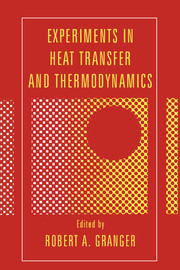Book contents
- Frontmatter
- Contents
- Preface
- Introduction
- Part I Experiments in heat transfer
- I.1 Conduction
- I.2 Convection
- I.3 Boiling
- I.4 Mixing, dispersion, and diffusion
- I.5 Radiation
- I.6 Heat pipes and exchangers
- Part II Experiments in thermodynamics
- Experiment 26 Effect of surface condition on attainable superheat of water
- Experiment 27 Experiments for compressibility and vapor pressure
- Experiment 28 Determination of time constants
- Experiment 29 Very fast versus very slow processes: Which are more efficient (closer to reversibility)?
- Experiment 30 Determination of volumetric fraction of each phase in multiphase flow
- Experiment 31 Measurement of the latent heat of vaporization of a liquid
- Experiment 32 Dilution techniques for the performance evaluation of continuous-flow combustion systems
- Appendix 1 Experiments and demonstrations in thermodynamics
- Appendix 2 Experiments and demonstrations in heat transfer
- Appendix 3 Heat-transfer and thermodynamic films
- Index
Experiment 27 - Experiments for compressibility and vapor pressure
Published online by Cambridge University Press: 05 June 2012
- Frontmatter
- Contents
- Preface
- Introduction
- Part I Experiments in heat transfer
- I.1 Conduction
- I.2 Convection
- I.3 Boiling
- I.4 Mixing, dispersion, and diffusion
- I.5 Radiation
- I.6 Heat pipes and exchangers
- Part II Experiments in thermodynamics
- Experiment 26 Effect of surface condition on attainable superheat of water
- Experiment 27 Experiments for compressibility and vapor pressure
- Experiment 28 Determination of time constants
- Experiment 29 Very fast versus very slow processes: Which are more efficient (closer to reversibility)?
- Experiment 30 Determination of volumetric fraction of each phase in multiphase flow
- Experiment 31 Measurement of the latent heat of vaporization of a liquid
- Experiment 32 Dilution techniques for the performance evaluation of continuous-flow combustion systems
- Appendix 1 Experiments and demonstrations in thermodynamics
- Appendix 2 Experiments and demonstrations in heat transfer
- Appendix 3 Heat-transfer and thermodynamic films
- Index
Summary
Principle
An experiment that involves the measurement of thermostatic properties is described. Temperatures and pressures of a real gas are measured in order that v(T, P) can be constructed. In addition the saturation pressure as a function of temperature Ps(T) is measured so that heats of vaporization can be evaluated.
Object
The primary objective of this experiment is the determination of v(T, P) and Ps(T) over a specified range of temperatures and pressures. In addition, other goals include the: (1) comparison of the measured v(T, P) data with published data and with v(T, P) functions obtained from the principle of corresponding states, and (2) comparison of the measured Ps(T) data with published data and the approximation ln (Ps(T)) = m/T + b.
Background
Most processes, devices, and systems built by engineers utilize gases and liquids. Such analysis and design invariably requires the evaluation of various thermostatic properties. For gases all thermostatic properties can be determined from knowledge of the “mechanical” equation of state v(T, P) and either the “thermal or caloric” equation of state (U = f(T, P)) or cp(T), which is the perfect-gas heat capacity. In addition to these functions, knowledge of Ps(T) provides a means of evaluating the thermostatic properties for two-phase materials. Finally, excursions into the liquid region also require that the heat capacity of the liquid be known.
- Type
- Chapter
- Information
- Experiments in Heat Transfer and Thermodynamics , pp. 208 - 216Publisher: Cambridge University PressPrint publication year: 1994



